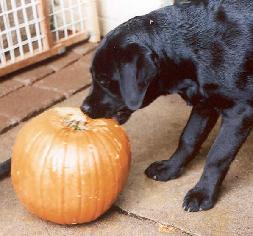Basic obedience training begins as soon as you take your pup home, but for the first few months, you will be teaching the pup what your commands mean, not demanding obedience. The exception is “no”, which can be enforced by simply picking up the pup and removing it from the problem. With basic obedience, as with housebreaking, logic and consistency are the keys to success. Make sure the dog (not just you) understands what your command means, and don’t give a command that you are not prepared to enforce.
| |
Remember to keep training short and repetitive. A few minutes each day or several times a week is better than a long session once a week. Put a lot of thought into what commands you will use, and when you will or won’t use them. For example, don’t use “stay” when you mean “sit”. If a dog doesn’t remain sitting, repeat “sit” and put it in a sitting position if necessary. “Stay” means that you are going to leave the dog, and it should remain where it is. “Stay” means “don’t come with me”. Try to give positive commands. Use “no” sparingly, if possible, and only for behavior that is never acceptable. Don’t use “no” when the pup barks, use “quiet” instead. Don’t say “no” when the pup jumps up onto the couch, if you are going to allow it up there later in the evening, but not now when company is present. Think of a different word that expresses what you really mean, like “off”.
|
| Don’t use similar words for different commands. “Down”, meaning “don’t jump on me”, and “lie down” are too similar and are confusing. Traditionally “down” is used for “lie down” and a word like “off” would be acceptable for “don’t jump on me”. You could use “no” for “don’t jump on me” if you never want your dog to do that, but if you sometimes encourage your dog to stand on its hind legs and give you a hug, or jump up to lick your face, then don’t use “no”.
|
Teaching “sit” is easy; “down” not much harder. “Come” is more difficult. In the beginning, use it when you know your pup will come (like when you have dinner in your hand). “Heel” is a more sophisticated concept, but in the beginning it can mean “walk by my side and don’t dart between my legs”. I don’t recommend public training classes before 6 months of age. Labradors do not require the early socialization that the more aggressive breeds may need, and the health risks are high. Also you do not want to expose them to other puppies that are aggressive at this stage in their development.
| |
| “Fetch” is easy with a Labrador, but make sure the pup actually sees what you throw and where. Its eyesight is still developing. “Fetch” means retrieve and bring it back. “Give” means release the object into the thrower’s hand. Many future problems will be avoided if you follow through on this entire sequence from the beginning.
|
Many Labrador puppies do like to garden and they especially like newly planted landscaping, so a dog run, or a fenced off area of your yard or patio can prevent a lot of grief and bad habits during the first 18-24 months.
| |
| Make sure you spend regular periods of time with your pup indoors teaching it to lie quietly and to be a good citizen in the house. This requires patience, but it is much easier to deal with a small rambunctious puppy than a large rambunctious adult.
|
Do not take a pup’s dish away from it while it is eating (as has been recommended in some books). Do not interfere with a dog’s meal and keep children away from a dog that is eating. If you are really concerned about a snapping response to touching while eating, pet the dog while it is eating so that it learns that touching does not mean that its food will be taken away.
|
 |
| Carving a jack-o-lantern |
|
|
Puppy teeth are razor sharp, but wear down quickly and are shed between 4-6 months of age. Be careful with your fingers and clothing when the pup jumps and grabs. This behavior should be discouraged, but since they usually do this when they are glad to see you, be careful what message you give. If a pup bites hard deliberately, grab it by the scruff of its neck and say ”no” sternly. If it has clamped down on your hand, press its upper lips up against the points of its teeth so that it is biting itself, and say “no” sternly. This is always effective.
|
It is quite natural for a very young Labrador pup to jump right into the water the first time it sees a swimming pool. This does not mean that it has any idea how to get out, or even how to swim for very long. Watch any dog, pup or adult, closely around a swimming pool unless you are sure it has been shown and remembers where are the stairs and how to use them, and you know that the dog can swim long enough to reach them.
| |
|
|